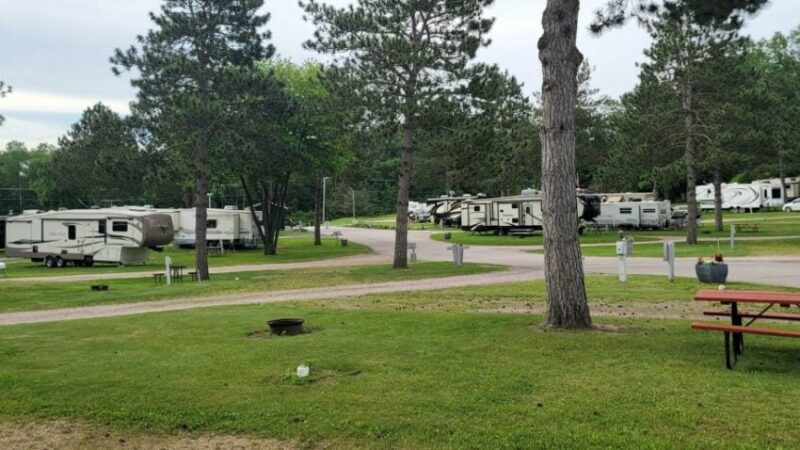High Altitude RVing: What Are The Potential Risks?

Camping In The Mountains? Here’s What You Should Know About RVing At High Elevations
RVing offers a unique and exciting opportunity to explore diverse landscapes. Your journey will likely take you through various terrains, including breathtaking mountainous regions. While these high altitudes provide access to mesmerizing views and plenty of campgrounds, it’s important to remember that RVing at such heights presents its own set of challenges and is not always an easy ride.
It takes time for our bodies to adjust to elevation changes. Rushing into steep inclines can cause serious medical issues, especially if you already suffer from health problems. In addition, many devices aren’t designed for high altitudes. They may malfunction or behave in strange ways.
Fortunately, you won’t have to worry about extreme altitude effects in most parts of the United States. But it’s still good to be aware of the risks and learn some ways to treat/prevent the side effects. Below, we’ll explore everything you need to know about RVing at a high altitude.
Watch out for altitude sickness
The first thing to be aware of is altitude sickness. Our bodies can adapt to different elevations, but sudden changes in pressure and oxygen levels can be harmful. Some people develop altitude sickness once they go 8,000 feet above sea level. This can manifest in a variety of ways, but common symptoms include:
- Headaches
- Nausea
- Fatigue
- Weakness
- Shortness of breath
- Rapid heartbeat
In extreme cases, you might even pass out or become delirious. You can adapt to a higher altitude over time, but it’s a good idea to gradually increase your elevation so you have time to get used to it.
Even if you’re feeling fine, your pets might develop altitude sickness as well. They have similar symptoms compared to humans, but there are a few other warning signs to watch out for. Pets might have pale gums, swollen faces, and bloody noses. If they develop these issues as you ascend, give them plenty of water, let them lie down, and retreat to lower ground immediately. Seek out a vet if they don’t improve after these steps.
Prepare for medical issues
In addition to altitude sickness, high elevation can cause a variety of other medical issues. The air is thinner and less oxygenated. If you have any respiratory conditions, you should try to avoid high altitude RVing (or at least pack plenty of inhalers, oxygen tanks, etc.).
You can also become dehydrated more easily in these conditions. In many cases, you’ll have to urinate more often, so your body will lose water at a rapid pace. Make sure you consume plenty of water (as well as drinks with electrolytes) to improve hydration.
High altitudes can also be pretty dry, so nosebleeds and cracked knuckles are quite common. Bring tissues and lotion to combat this. Vaseline or nasal sprays are also helpful because they will prevent your nose from bleeding.
Expect lower tire pressure
RV tires tend to lose pressure in the cold, thin air. Underinflated tires aren’t nearly as effective, and this results in uneven tread wear. In addition, your gas mileage will suffer because it takes more energy to rotate the tires. You may need to reinflate your tires on a regular basis when you camp in high altitude areas.
A tire pressure monitoring system can be a lifesaver in these circumstances. It can warn you if your pressure is uneven, plus it can alert you to any leaks or sudden changes.
Be aware of increased UV exposure
The closer you are to the sun, the more you have to worry about UV radiation. The atmosphere gets thinner as you travel in areas with high elevation. You don’t have much protection from the sun, so you’re more likely to get sunburned. That’s why you need to take extra measures to protect yourself and your vehicle!
Wear sunglasses, full-length clothing, hats, and sunscreen as much as possible. Your vehicle can also be damaged by excessive UV exposure, so use a cover to protect it. Limit your daytime activity as well. The less time you spend in the sun, the better off you’ll be!
Winterize your RV for colder temperatures
The higher you go, the colder the air is. You can sometimes find snow in the middle of summer when you’re up in the mountains. The temperature can also drop drastically at night, so you’d better get ready for some chilly camping. If your RV is not properly prepared for these conditions, you’ll run into some issues.
Winterization is key to high altitude RVing. You need to ensure that your water tanks don’t freeze when the temperature drops. An enclosed underbelly is helpful, but you can also use heated tank pads to stave off the cold. Protective covers for your RV body and wheels can also be helpful.
You’ll need to pack plenty of blankets, heaters, and warm clothing for yourself as well. Try to bring a couple of different types of heaters just to be safe. You can use electric heaters, solar-powered models, or propane appliances. Even wood-burning stoves can come in handy! Just make sure to follow proper fire safety protocol.
Vehicles will be under greater strain
In order to enjoy high altitude camping, you have to get to your destination! If you travel in an RV, that means that your vehicle will be tackling some pretty steep inclines. Altitude can affect various pieces of your vehicle, and its performance may suffer as a result.
In general, engines will lose about 10% of their power with every 3,000 feet you climb. It’s also more likely for an engine to overheat at these heights, so keep an eye out for that. Don’t ignore burning smells or visible smoke.
In addition, the roads and paths through the mountains can be taxing. You may wear out your brakes if you travel up and down steep grades. Your gas mileage will also suffer because of the varying speeds and angles. You’ll have to spend a fair amount of money to fuel up your rig if you plan to travel and camp at a high elevation.
Plan for poor cell phone reception
Access to modern comforts is one of the best parts of traveling in an RV! But cell phone service and Wi-Fi can be hard to find once you get high enough. Elevated regions also tend to be less populated, so many networks don’t offer coverage.
If you need to stay in touch with others while you camp, you may need to use a signal booster or a satellite phone/GPS. These are a bit inconvenient, but they get the job done!
Be aware of cooking/baking differences
If you plan to cook your own food on the slopes, you need to know how high-altitude cooking works. One of the most important things to remember is that water boils at a lower temperature in the mountains. So, even though you might see it boiling and steaming, it’s often not as hot as it should be.
Therefore, you need to increase your cook time to make up for this change. You should generally add 25% more cook time to be safe. This rule doesn’t apply to food that you cook over a campfire, though! You can always rely on the temperature of the flames, so make as many campfire meals as you want.
Baking is another issue altogether. Elevation changes can affect your cook time, as well as the rising time for bread and other yeast products. In many cases, you’ll have to increase your baking time to get a satisfactory result. It’s a complicated situation, so just keep an eye on your food and use thermometers to check the temperature.
Plan an RV-safe route
For all of your camping and trip planning needs, look no further than RV LIFE Campgrounds and RV LIFE Trip Wizard. Campground Reviews is a trusted source of campground and RV park reviews offered by camping and RV enthusiasts just like you. With its accompanying RV LIFE App, RV Trip Wizard gets you to your camping destinations utilizing RV-friendly routes specific to your RV and travel preferences.
Been to a campground lately? Don’t forget to leave a review! Reviews help other RVers like yourself, and they help the campground. Leave a campground review today!
Related articles:
- Altitude’s Effects On RV Living And What You Can Do About It
- Tips for Driving an RV on Extreme Mountain Grades
- Camping In Colorado: Take Your Vacation To New Heights
The post High Altitude RVing: What Are The Potential Risks? appeared first on RV LIFE.







